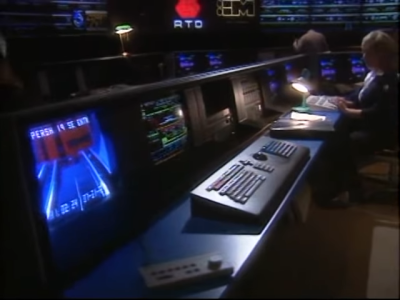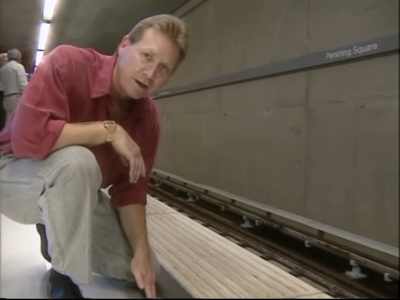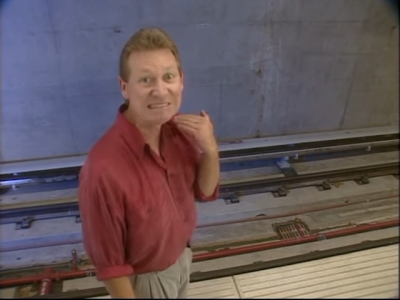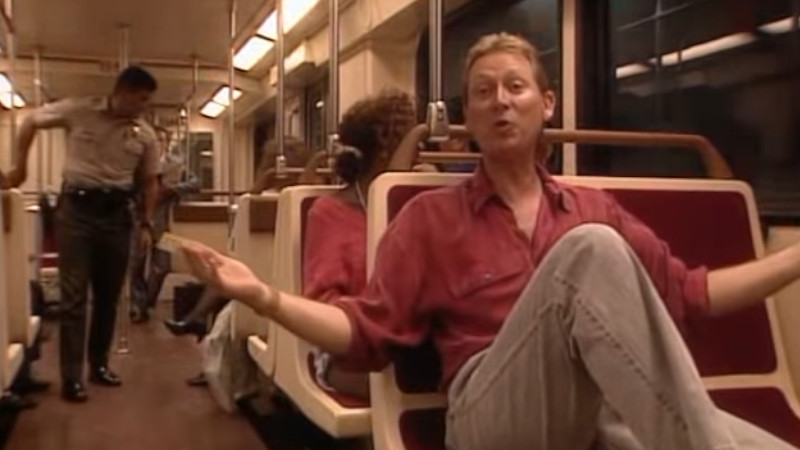Subways! They’ve been around for an awfully long time; almost as long as modern railways themselves, believe it or not. Building underground was undertaken in earnest by those in the 19th century, who set out to build networks of stations to allow residents to get around a city quickly and effectively.
That fact should stick in your mind as you sample this glorious retro video from 1992. “L.A. Underground – Safety in the Extreme” is a guide for Californians, aiming to educate residents about the new B Line subway that opened the following year. The video acts as if the subway is a new fangled, mysterious thing, with a couple of confusing off-the-wall moments as well. If you’re a transport enthusiast or get excited about weird public films, this one’s for you.
Straight away, we’re greeted by a lively, dynamic man in a red shirt, who is clearly here to give us the scoop on something new and hip. “Union station to Hollywood and Vine in EIGHTEEN minutes! Impossible you say? Well, not anymore!” he says. He challenges the viewer, noting that “No, Scotty isn’t gonna beam you up over there, and it’s not a helicopter.” What is it then? “It’s the subway!”

This upbeat, fun, and freewheeling tone is par for the course in this video, which sets out to deliver a great deal of information while also being engaging for the viewer. Production is unfussy, slick, and clean, with well-composed shots and straightforward messaging. It’s also refreshingly free of gaudy transitions and grating muzak, something rare in this genre. It’s a testament to the skills of the team that put the film together.
It’s a film that could strike many viewers as odd, given that it seems to treat its audience as if they’ve never heard of a subway before. Given the famous New York subway which is heavily featured in American culture and any number of other systems around the country and the world, it might be confusing as to why this is even needed at all.
As always, however, context is everything. The 1989 Loma Prieta earthquake would be fresh in the minds of many Angelenos in 1992. Up in San Francisco the quake had caused the horrifying collapse of the upper deck of the bay bridge, with thousands injured and 63 killed in the disaster. It’s thus easy to understand why the city’s population would be reluctant to travel deep underground for fear of being trapped in the event of another quake.
Indeed, a great deal of time in the film is spent allaying these concerns. It notes that despite the intensity of the Loma Prieta quake, minimal damage was done to the BART subway system — whose construction was the focus of another installment of our Retrotechtacular series. The lines were running again within hours of the incident, after appropriate safety inspections. As it turns out, subway stations are actually relatively safe places to be in an earthquake, and can often be safer than skyscrapers or other above-ground buildings.

The host’s expression leaves no room to argue.
The focus on safety is, well… extreme, as you might have guessed from the title. The advanced nature of the system is explored too. There’s discussion of the high level of technology integration and a look at the now retro-futuristic Central Control Facility, or CCF, with rows of computers and wall displays making it look like a distant cousin of NASA’s Mission Control. CCF is portrayed as somewhat of a benevolent, loving god, watching over the subway and its passengers at all times.
The staff at CCF are even shown directing police to help an old lady find her glasses, a service we’re not sure is still offered in 2021. When the host takes a step over the line at the edge of the platform, he’s immediately admonished by a disembodied voice, instructing him to move away. The CCF runs a tight ship, it seems, and they won’t have any of that tomfoolery in their subway.
Notably, the subway relies on the honor system over ticket turnstiles. “We know that the honor system works,” says the host, “because 98% of the passengers on the Metro Blue Line pay their fares!” Again, that wide-eyed, friendly smile. The film spares no words as to the fate of the other 2%.

The host goes over emergency procedures in detail, noting step by step what will happen if something goes wrong. Highlights are made of the walkways built into the subway tunnels, so that riders don’t have to walk on the tracks in an incident. There’s also special note of the bright lighting and wide double doors that do much to allay concerns of claustrophobia underground. This sequence ends as the host exits an emergency hatch that opens up on to the sidewalk. It’s here that he delivers the greatest line of the entire film. “Good evening! I’d like to introduce myself,” he boldly announces in a credible Dracula impression. “My name is Count Safety, and this is my subway!” He then proceeds to lose himself in maniacal laughter.
All jokes aside, it really is a glorious piece of public messaging, one that I’ve watched over ten times since first finding it last year. I’m sure it did a great job of acclimatizing Los Angeles residents to their shiny new subway system.
This copy of the film comes to us from the Dorothy Peyton Grey Transportation Library and Archive. First established in 1895 as a part of the Los Angeles Consolidated Electric Railway, it has been maintained ever since and holds a catalogue of information on transport in and around Southern California. The library’s catalog is available online for those eager to hunt for further gems like this one.
The video was the work of the Los Angeles County Transportation Commission’s own in-house video production facility. Producer Erica Goebel was responsible for putting the project together, one of many great public films she produced over an esteemed career with the organisation. Sadly, that in-house department was shutdown in 1993 and future work was outsourced. Given the quality of this video, we think you’ll agree that decision was a great shame. In any case, it’s a beautiful relic of its time and the whole team should be proud of what they achieved. They certainly put a smile on this writer’s face, for sure!
















I recently learned LA has a “smog season”. Something must have gone terrybly wrong with this city’s public transport policy.
Unfortunately there will never be a transport system that is up to the task of sprawl in greater LA. Better to put your hope in EVs.
I think it is doable, but would be too costly and would require too much rebuilding to be implemented. Also I think that in USA people prefer to use their personal cars rather than public transport…
From what I’ve seen “in USA people prefer to use their personal cars rather than public transport” is equivalent to me saying “I prefer to walk rather than fly on the back of a giant eagle”.
L.A. has an extensive bus system. However, if where you are and where you want to go aren’t on the same line, expect a 40-minute trip to take 2 hours.
There’s a bus system in LA? There are busses on routes, but unless you like to walk a lot, you can’t get there from here.
You really should watch the movie “Roger Rabbit”
While he should watch Roger Rabbit because it’s a good movie I think you’re refering to the great streetcar conspiracy.
https://en.wikipedia.org/wiki/General_Motors_streetcar_conspiracy
Said public transport (specifically buses) is probably a substantial contributor to the smog…
Man, everything he says makes it sound like everyday life in LA is dangerous and full of fear.
https://youtu.be/eFvnhM2A2Ok?t=447 The end!
It would have been cheaper just to put up signs saying “You’re in a train in a hole, so sit down, shut up and try not to shoot each other!”
This video really impresses me, seriously.
Alas, because I’m not from the US (European here), I can’t really judge due to the lack of comparison,
but it seems to me that the atmosphere and technology (the whole concept, in fact) was much more
sophisticated than it is now. Everything in this video made so much sense, IMHO.
The white, bright location, the 80s neon lights, the darkened control room without any Windows GUIs
that may distract from the main application’s data (also notice the use of primary colours on these well aranged CRTs)..
If I had anything to complain, that it would be the lack of plants and tactile/audible information for blind people.
slightly weird in the video at 11:45 they show an emergency exit to the street that is horizontal doors that open upwards into the street, apparently without warning. with both doors open a chain blocks people from walking into the hole, but with only one door open the chain is slack and makes a real hazard for pedestrians to fall into the stairs. why would it be so difficult to make a stairway with regular doors above street level?
Not difficult, but ugly and not necessary. Emergency doors like these are used maybe once every 30 years (not per door, but one in the entire system) without it being foreseen, and in the cases of training/maintnance they could cordon off the doors.
I have been on public transport in many countries, on many continents in the world, but I must say that in the US, public transport sucks, to the point that I don’t use it at all anymore.
I have visited many states, and everything from small villages in the rural north to the big citys in California, and NY
Either the public transport is unsufficient, or it is dirty and dangerous, filled with crackheads and homeless people.
I feel safer in the metro in Medellin Colombia then in the big citys in USA, Moscow has a beutiful clean subway compared to anywhere in the USA, and Londons Subway is also great att shutteling people to where they need.
Berlin has a great subway net, combined with trams and busses, all on one ticket.
On the 1974 NYC subway system, see the excellent 1974 film, The Taking of Pelham One Two Three.